Feb 6, 2014 | bullion, coins, commentary, counterfeit
Of all the threats to the numismatics industry one stands out as being the biggest threat: counterfeiting. While thefts and violence of dealers are tragedies, the theft is more localized and easier to deal with because, for the most part, criminals are stupid and leave evidence. Also, since the dealer community is small and there is cooperation from the pawn industry, there is a higher resolution from thefts than expected.
Counterfeiting is worse. Counterfeiting can be a systemic problem that infects the industry in the same way a virus infects your body. To extend the analogy, thefts would be like breaking a finger. It will hurt and cause problems, but the rest of the body will survive. A virus hurts the entire body.
A counterfeit coin is added to the market and is sold to an unsuspecting buyer. The buyer figures out that the coin is counterfeit and is usually embarrassed to admit their mistake. Rather than report the crime or just chalk it up to bad luck, they try to resell the coin, even at a loss, to make up some of the money. The buyer, who is now the reseller, can plead ignorance by claiming buyer’s remorse and say that they decided they did not want the coin.
Overseas counterfeiters, mostly from China, also setup broker networks where they sell their creations to United States-based sellers for them to sell to unsuspecting buyers. While many use online sources to sell these counterfeits, many will try to sell them to low-end coin shops, bullion traders like the ones who setup in hotel rooms, and pawn shops. Unfortunately, they are successful in selling of these items to what should be trusted dealers keeping them in hobby circulation like a virus coursing through your veins.
The problem is not limited to raw coins. Counterfeiters have figured out ways to counterfeiting both the NGC and PCGS holders along with their holographs and seals in order to fool potential customers. Since both companies make it easy to look up serial numbers via their websites, counterfeiters will use the serial number of a real coin and counterfeit that coin for the holder. Both NGC and PCGS have been doing as much as technology allows when upgrading their holders and holographic seals to thwart counterfeiters.
A reminder of the issue landed in Inboxes today from Doug Davis of the Numismatic Crime Information Center. Rather than describe the warning, here it is in its entirety:
COUNTERFEIT SUSPECT
Dealers in Illinois, Missouri, Oklahoma and Kansas should be on the look out for a suspect selling counterfeit coins and bullion within the last ten days. The suspect has been identified as Gabe Owen and sometimes uses the alias Garet or Gabriel Owen. Owen is a white male and uses a Kansas driver’s license or a passport as identification. The vehicle driven by Owen is a white Yukon or Tahoe.
Owen is attempting to sell gold bars, one ounce gold eagles, a 1795 PCGS VF dollar and silver eagles. The same suspect was identified in similar incidents and reported by NCIC approximately one year ago.
We are working with authorities to get a current photo. At the present time there is no outstanding warrant for this subject.
A basic tool against counterfeiting is education. You should know and understand what you are buying. While this sounds basic, you have to think about the coins you are purchasing. For example, collectors of Morgan dollars might think they know what the coin looks like and what to look for, but do you really know? Could that variation in the strike be a known variety, known as VAMs after ground breaking research into Morgan dollar die varieties by Leroy C. Van Allen and A. George Mallis? What if it is a real Morgan dollar that was once cleaned or tooled that would be at least worth its value in silver?
Even if you do not have the education give a definitive answer, how many times have you heard the target of a scam say that something did not seem right or that they questioned a lot of what the seller was saying? More times than not, these instincts are usually right and the few times they are not right, you should feel better knowing that at least you had the sense to listen to that inner voice because you might need it next time.
Always remember, if the deal is too good to be true, it probably is not a good deal!
While counterfeiting is illegal and there are protections under the Hobby Protection Act, the only person that can be prosecuted is the seller. Under the law, the only other person who could be prosecuted is the manufacturer. In most cases, the manufacturer is outside of the United States and beyond the reach of law enforcement.
One tool that can help is H.R. 2754, the Collectible Coin Protection Act. The Collectible Coin Protection Act updates the Hobby Protection Act by allowing law enforcement to target the distributors as well as the sellers. By making the changes H.R. 2754 prescribes, it allows law enforcement to cut off the supply lines from the counterfeit manufacturers.
H.R. 2754 passed the House of Representatives on July 30, 2013 and was sent to Senate for their consideration. However, the bill is sitting in the Senate Commerce, Science, and Transportation waiting to be scheduled. Even if your senators are not a member of this committee, if they hear from constituents that this is a concern, they will speak with the committee chairman Sen. Jay Rockefeller (D-WV) or the ranking member Sen. John Thune (R-SD) to bring this to a vote.
Be part of the antidote to this virus and go to senate.gov, use the pull down menu in the upper-right corner of the page to select the state you live or work. Please contact both of your senators and let them know that you support the Collectible Coin Protection Act. When you contact your senators, tell them that the bill is revenue neutral. It will not add to the deficit and will not require additional appropriations.
In the meantime, please be careful and educate yourself before making that purchase. Buy the book before you buy the coin may be more important now than ever.
The advantage is that almost any book at almost any price is a bargain. You cannot buy them much cheaper. The profits come from knowing what is between the covers. The best collections are built on knowledge, not price sheets.
I could not have said it better!
Jan 29, 2014 | ANA, books, commentary, technology
Since learning to program computers in 1976, I have been a proponent of technology and its positive effects on the progresses we have made in many areas of our lives. This technology has progressed things we can see like the automated teller machine, quicker checkouts at the grocery stores, smartphones, tablets, and even all the gizmos in your car. If I look at the iPhone in my pocket and compared it to the Poly 88 that I first programmed or the IBM 360 that I submitted punch cards to, it would be like trying to compare a Roman Denarius to an American Silver Eagle.

For those not olde enough to remember, this is a computer punch card!
I love what technology has done to enhance many aspects of our lives. And you do not have to be a user of technology to have it affect the way you live. Computers help with inventory control to ensure store shelves are stocked; manage traffic control both in the air and on the ground; and generally make the behind-the-scenes management of a lot of things easier including maintenance on this blog.
Since my response to Dennis Tucker, Publisher of Whitman Publishing LLC, I have received a mix of private email notes about one phrase: calling physical books ‘Dead Tree Editions.” In the first two hours after the post appeared, I received more than two-dozen email notes running slightly in favor of physical books. As of Wednesday afternoon, the score was 17-15 in favor of real paper.
I do not know the demographics of those who did not volunteer the information, but based on the comments like, “I have been collecting for umpteen years…” or “I was a teenager when clad coins were just beginning…” it does not take much to get a general idea of demographics.
Of the 17 who responded that they prefer paper books over e-book, I am guessing that 12 are like me, members of the AARP demographic (50 and over).
However, contrary to what some have written, I am not a techno-snob!
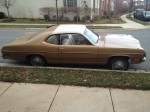
Scott’s 1974 Plymouth Gold Duster. No computers in this baby!!
For more images of this car, click here.
My complaint is not with the preference but the availability of e-books that will allow me and everyone else to choose. I understand the need for choice because neither Whitman nor I will convince everyone to only read e-books.
However, if you look at the demographics of the ANA and its future, the next generation that are its future members, the so-called Generation X people, is the first generation of significant technology adapters and e-book readers. Gen X’ers are the first big wave of technology adapters who know of a connected world and have a vague memory of a world before Al Gore invented the Internet.
Right behind Generation X are the Millennials who grew up with the explosion of the Internet and probably have never read a newspaper cover-to-cover. While hobby publishers may have some time adjusting with Generation X, they will lose completely to the Millennials if they do not adapt.
Whitman is not the only publisher that needs to better examine its use of technology. Krause Publications is not much better. Where Whitman lacks in vision, Krasue lacks in execution. Rather than embrace electronic publishing that is friendly to e-readers, Krause and F+W Media, its parent, is holding onto the old-style by offering its products using Portable Document Format (PDF) rather than using formats that are friendlier to e-readers.
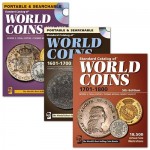
Standard Catalog of World Coins CD set covering 1601-1900
Even the venerable Numismatic News has stuck its publishing toe in the e-publishing waters by making one edition electronic. However, instead of embracing the newsstand formats that would be friendly to an iPad or Kindle e-reader, they are mailing PDF layouts of this publication. I hope you have plenty of space in your Inbox.
In the meantime, the American Numismatic Association is producing an e-reader friendly version of The Numismatist that is far easier to read than the PDF edition of Numismatic News emailed monthly. Since The Numismatist reader app works well, I stopped receiving the paper edition of The Numismatist opting for a Basic membership and to read the journal electronically. I do not miss the “Dead Tree Edition.”
 It is not a demographic issue as it is a commitment to the hobby’s future. I am sure the people at Hemming’s Motor News have a similar problem with demographics as those faced by Whitman and F+W. If you read their publications, you will notice that their demographic skews to an older population. Yet, they have quietly embraced the technologies that some of their readers want while still publishing physical magazines. I recently subscribed to the digital version of Hemming’s Classic Car on my iPad and love it!
It is not a demographic issue as it is a commitment to the hobby’s future. I am sure the people at Hemming’s Motor News have a similar problem with demographics as those faced by Whitman and F+W. If you read their publications, you will notice that their demographic skews to an older population. Yet, they have quietly embraced the technologies that some of their readers want while still publishing physical magazines. I recently subscribed to the digital version of Hemming’s Classic Car on my iPad and love it!
How could Hemming’s do this for the auto enthusiasts market but Whitman and F+W cannot do the same for numismatics?
Whitman and F+W have shown that they cannot be relied upon to be the leaders in producing the numismatic information in a way the future of the hobby will embrace. Since other markets have proven that it is possible to embrace technology to enhance the physical world, I can only emphasis my commitment to help the ANA build a better technology infrastructure because if we leave it to the market, they will fail the hobby.
Jan 28, 2014 | ANA, books, commentary, technology, web
In letter to the editor that will appear in the February 10, 2014 edition of Coin World (now available online), Dennis Tucker writes that the target of the American Numismatic Association website rebuild and acknowledging “’Young Numismatists are the future of the hobby’ are slogans to murmur approvingly, without logical reasoning.” He goes on to give his view of the market to target without recognizing facts of market forces.
For the record, Dennis Tucker is the publisher of Whitman Publishing, LLC whose books are widely read in the hobby. Whitman Expo, a division of Whitman Publishing, runs probably the three largest commercial numismatics shows in the country out of Baltimore.
Tucker, whose business is selling physical books, or what I would call “dead tree editions,” opines that it would be wiser and more productive to target those in the 50 and 60 year old demographic than 10 and 20 year olds. It is obvious that Tucker is looking at the issue from the spectrum of the business he is responsible for rather than the real future.
One problem with Tucker’s argument is similar to those in many other hobbies that rely on the collecting of physical objects: if the hobby cannot be translated to the younger demographic then the future of the hobby will be lost. As the final wave of the baby boomer generation celebrates their 50th birthday this year, empty chairs are becoming more prominent at meetings with fewer standing there to fill those chairs. There seems to be a smaller pool of people ready to join even though the population in the demographic that Tucker wants to target has grown.
Another problem with his argument is that it does not address how to reach this or any other demographic. Based on his company’s business model and his letter, Tucker is implying that even his target demographic is not using technology and cannot be reached using technology. Unfortunately, that flies in the face of researched facts.
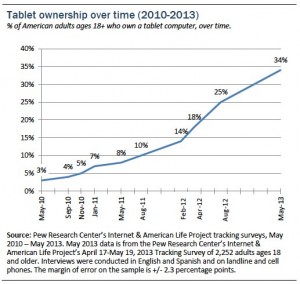
Pew Internet and Lifestyle Study: For the first time, a third of American adults own tablet computers
Using tablets as a barometer, we can look at the “Tablet Ownership 2013” report from the Pew Internet and American Life Project. In their study, Pew reports that through May 2013, tablet ownership has grown from May 2010, one month after the iPad’s introduction, the number of tablet users have increased from 3-percent to 34-percent. That is more than an 1100-percent increase in three years!
Further, Pew’s research found that the demographic with the most significant ownership are the age group of 45-54 with 38-percent ownership and 35-44 with 49-percent. The first is part of the market that Tucker wants to target while the latter is the market that should be next.
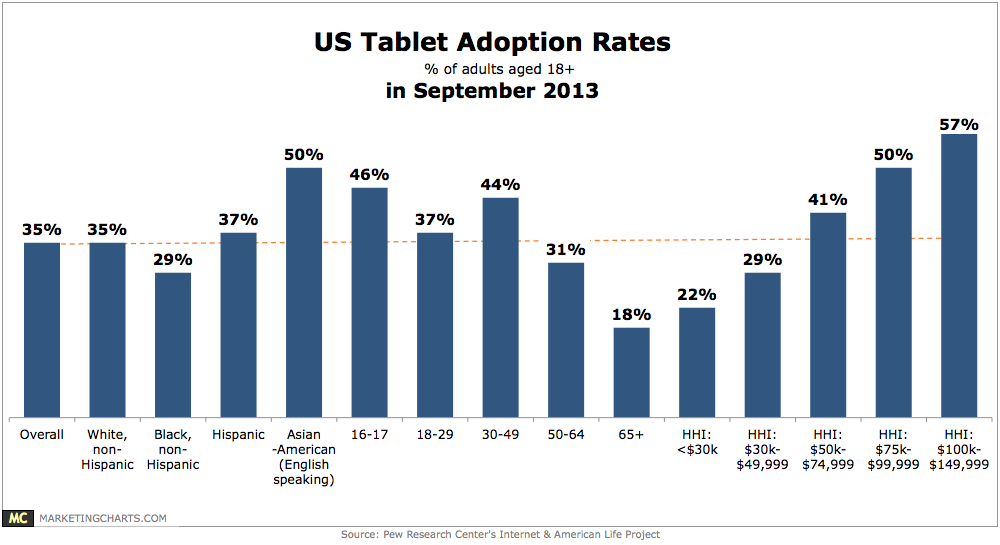
US Tablet Owner Demographics as of September 2013 (courtesy of marketcharts.com)
Pew’s research also looked at tablet ownership by income and found that 56-percent of adults that own tablets earn $75,000 or more per year. If Tucker’s goal is to target those with disposable income, just look at one of the fastest growing area of technology to understand where the markets are going.
Another study recently release by Pew notes that e-book readership has grown as the sales of e-readers have risen. While the study does not say people have not completely replaced their dead tree versions with electronic editions, there is anecdotal evidence that if more titles were available electronically, those with e-readers would take advantage of that.
In a broader look at the emerging online world, Pew Research provides trend data that shows that more people are using the technology in their daily lives. Not only are more than 60-percent of the 50-64 year old demographic using the Internet and associated technologies a large numbers, but e-reader ownership is increasing. It is also increasing in the younger demographics, including those in the 30-49 year old range who would be Tucker’s next generation of customers.
The ANA, like any business, has to adapt to new markets or they lose their relevancy. It is not enough to say to target one group over the other but you have to target the markets where they are moving. Even if the business is concentrated in one market, it has to adapt and diversify within its market or it becomes irrelevant. As a stark example, you can look at the downfall of Blackberry. Once the king of the smartphone, Blackberry, once called the Crackberry because its users were addicted to it like a crack addict was addicted to crack-cocaine, went from the most popular phone to the least popular phone because they ignored the trend set first by Apple then by Google’s Android.

Borders, a one-time success story, did not adapt to the changing market and paid for that failure.
Whitman and Tucker could help the ANA by looking at this future and target their books to this growing demographic. While the quality of Whitman’s books have improved, the companies selling tablets and e-readers are reporting increased sales of their products and an increased sales of content for those products.
Amazon is betting a lot on the tablet and e-reader market. They sell the Kindle nearly at their cost in order to lure customers into their dedicated markets. Amazon hopes to sell you a Kindle so that you buy their e-content which they make money by transferring bits. Not only has Amazon built in the infrastructure to transfer bits of information, but they are selling it as a service to others in order to reach the same markets. Amazon is betting that once you are in their market, they can sell you these bits, which are cheaper to store, package, and ship than dead tree edition books.
While the e-book market is growing, Whitman and other hobby publications are dipping their proverbial toes in this market. Although Whitman does offer a number of its books in e-reader format, they do not market that fact nor do they do any outreach in order to build that market. It is as if they publish this content so that when the topic comes up they could say that they do have e-books. They are checking the box, so to speak.
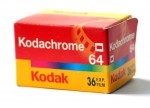
Kodachrome; You give us those nice bright colors; You give us the greens of summers; Makes you think all the world's a sunny day, oh yeah!
Growing the ANA is like growing a business; you have to look at what your target market’s demographics are and figure out how to reach them. For hobbies like numismatics, the new target is online where the current generation is moving and where the next few generations will be. Not adapting to those new markets can make both the ANA and Whitman as relevant as the Betamax and go the way of Woolworth’s or Pets.com.
I am glad the ANA is doing something to expand its market.
Trend chart courtesy of the Pew Internet and American Life Project
Data chart of the Pew Research courtesy of
marketcharts.comImage of Borders closing is courtesy of
PennLive.com.
Kodachrome box image courtesy of
Wikipedia.
Kodachrome lyrics (image caption) by Paul Simon
Jan 24, 2014 | advice, coins, commentary
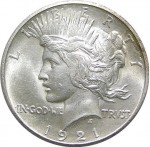 If you have not read “Hobby Must Fill the ‘Empty Chair’” that Michael S. Turini wrote a few weeks ago, then click here to read it first. Go ahead, I’ll wait.
If you have not read “Hobby Must Fill the ‘Empty Chair’” that Michael S. Turini wrote a few weeks ago, then click here to read it first. Go ahead, I’ll wait.
How do we fill the empty chair?
After years of growth spurned by the 50 State Quarters program, the hobby seems to have plateaued at levels lower than expected. Explanations for the slowing in the hobby’s growth range from the downturn in the economy through the downturn in confidence of the products being produced by the U.S. Mint.
I think Michael Turini stumbled on the problem: those of us most interested are getting old.
Not only are we getting old, but we are not doing what it takes to make numismatics inviting to younger members.
We seem to do pretty well in attracting young numismatists (YN), those under 18 years old. In fact, there are programs that actively recruit YNs for the hobby. But we are not doing enough. Not only are there no programs to keep YNs interested after they stop being YNs, there is a real lack of diversity in the hobby.
During my recent trip to Orlando for the 2014 FUN Show, I noticed that there were an increased number of women than I have seen at other shows. I also noticed that other minorities were attracted to the show. Seeing this was great, but how can it be spread to more areas of the hobby?
Numismatics can be a fascinating look at our history. The money that was used reflects the economy of the time which can tell a great story. What can the Morgan dollar teach us about the history of silver, the economy, and the politics of the time that could interest someone? Would learning about the ‘Crime of ’73’ make people think differently about the impact of politics on our economy?
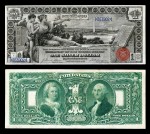
“History Instructing Youth” Educational Series $1 Silver Certificate, Series 1898,
Our thoughts may also be too old.
There are great stories in other areas of numismatics beyond coins and currency. So-called dollars, tokens and medals the size of a dollar coin, were struck to commemorate something, some event, dedication, or anything of significance. So-called dollars tell stories that coin cannot and yet does not get the same attention in the numismatic press as coins.
If you are looking for new numismatic areas to explore or to use as a source to educate someone about history using numismatics, what about items like trade tokens or tax tokens? Trade and tax tokens were local currencies used to build business. In many ways, trade tokens could be considered coupons before someone issued paper coupons!
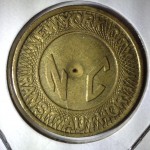
New York City Type 2 Subway Token error. It’s missing the punched out “Y”
In Canada, there are collectors who collect the interesting coupons from a particular tire company.
I know a European-based collector who collects communion medals from a particular region because it traces the history of Catholicism in the area where his family has lived for centuries.
You can even collect the coins of the country where your ancestors or other members of your family are from. I became interested in Canadian coins since my wife’s family is from Canada. Now I am looking at the large cents produced during Queen Victoria’s reign which are affectionately called ‘Vickie Cents.’
Numismatics does not have to be about plugging coins into the holes of a folder or album. It does not have to be about buying coins encased in plastic holders with high numbers or extra symbols. Use numismatics to learn about your past. You can learn more about yourself by understanding your past and what better way to understand your ancestral past than to collect something from that era.
Go collect something new and make sure you tell people about your finds. Tell someone the interesting stories of the past using numismatics as the prop. Make sure you tell them they can have fun with this, as well. Then invite them to your next club meeting and make sure someone is there to talk about their finds and history.
It is only when we can move beyond the cold metal and paper to make the stories interesting can we think about filling all of the empty chairs in the room.
Jan 16, 2014 | ANA, commentary, news, shows
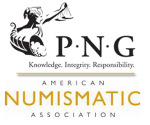 According to a press release issued on January 15, 2014, the Professional Numismatists Guild and the American Numismatic Association will jointly host “the first” PNG-ANA Numismatic Trade Show the weekend prior to the 2014 World’s Fair of Money in Rosemont that will be open to the public.
According to a press release issued on January 15, 2014, the Professional Numismatists Guild and the American Numismatic Association will jointly host “the first” PNG-ANA Numismatic Trade Show the weekend prior to the 2014 World’s Fair of Money in Rosemont that will be open to the public.
The PNG-ANA Numismatic Trade Show will be Saturday through Monday, August 2-4, 2014. The World’s Fair of Money will be held Tuesday, August 5 through Friday, August 9, 2014.
Doing this eliminates PNG Day(s) prior to the World’s Fair of Money and will extend the entire show week to eight days.
It was my understanding the PNG Day was for PNG members to buy and trade amongst themselves to prepare inventory for future sales. Inventories were bolstered by wholesale dealers or dealers who would rather sell to other dealers rather than staff a table at the World’s Fair of Money. While it was closed to the public, it was possible to either buy your way into the PNG show or get an invitation from a PNG member dealer.
What may have been the driver of this decision is that it was getting easier to obtain an invitation from a PNG dealer. Citizens of some of the popular coin forums would be able to download an invitation posted by member dealers to use for PNG day. A friend who attended PNG Day in 2013 said that non-members clearly outnumbered members by a large margin.
Where I question the decision is that it makes the show eight days long—emphasis on long. While some dealers will not attend both shows, there are many dealers who will be there all week. Those of us who are buyers know that some dealers can get surly toward the end of a show like the World’s Fair of Money. Can you imagine how prickly these dealers will be by August 8?
With the show ending on a Friday, a day that will attract local attendees, will the long show, cranky dealers, and the inevitable empty tables turn the World’s Fair of Money into a bad showing for the ANA?
As part of the PNG-ANA show, there will be a daily give away of a Double Eagle gold coin that will be donated by a PNG member dealer. There will also be an auction by Stacks-Bowers Galleries.
There will be no similar give away for the World’s Fair of Money. Both Stacks-Bowers and Heritage Auctions will combine to be the official auction of the World’s Fair of Money.
Since Numismatic Guarantee Corporation is the official grading service of both organizations, they will be present for the entire week. Good luck keeping staff motivated!
This decision brings back the concept of a pre-show that was discontinued because it was poorly attended and made the week too long. It also has the possibility of up staging the ANA and the World’s Fair of Money.
Since most collectors work people outside of the numismatics industry and Rosemont is not exactly a destination location for families, this will increase the attendance during the weekend of the ANA-PNG show rather than during the week for what should be the premier show, the World’s Fair of Money. Casual collectors who have to arrange for travel and time off from work will be more attracted to the co-branded show on the weekend rather than the ANA show.
The ANA should not give up its premier status to share the stage with PNG.
While the ANA should work with PNG and other organizations, the ANA should not play second fiddle to any other organization regardless of the organization. If the ANA wants to be the premier numismatic organization, the one that anyone wanting to learn about and be about numismatics, this type of partnership that has been clearly driven by PNG is not the right way to be premier.
This is a bad decision for and by the ANA.
Jan 14, 2014 | coins, fun, shows, silver, tokens
Going to a coin show in another area of the country is an education on seeing how others do the shows and meeting dealers who do not travel to your area. For me, attending the FUN Convention in Orlando was this type of experience. Yes, there were the usual big name, high volume, and high-end dealers present as they are at any show, but there are other dealers whom I have never met before.
Saturday was spent in three parts. When I arrived at the convention center, I went directly to the exhibits area. As a wannabe exhibitor with two (what I think are) good ideas, I wanted to see how others present their ideas. For the most part, I was a little disappointed in the exhibits. Many were mundane and typical. There were only a few exhibits that really stood out.
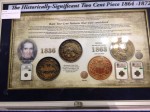
This Historically Significant 2-cent Piece by Tom Ulram of PAN
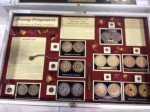
“Penny Potpourri” by Charmy Harker won Best in Class, Show, and People’s Choice
The second part of my day was schmoozing. There is nothing like meeting numismatists of all type on a bourse floor and just talk with them. I spoke with people I know, dealers I did not know until I sat at their table, and with visitors looking at various items wanting more information. I had the most fun at the American Numismatic Association traveling exhibit explaining the history behind the various items of currency that were on display.
Speaking of the ANA traveling exhibit, I was a little disappointed in the presentation of what was exhibited. Aside from not having the currency labeled with information, the case with the errors had just coins placed in the case without description or context. Many of the bland collector exhibits were done better than what the ANA presented.
FUN organizers understand that the idea of having a how is to have fun (pun intended). One exhibit area that I have only seen at FUN is the artists’ area. The artists’ area was in the back of the hall off the center aisle where tables were set in a square that hand artists making jewelry and art from coins. There were a number of artists making modern Hobo Nickels, a bead artist who used coins as part of the beading work, and someone who made large rings with carved coins.
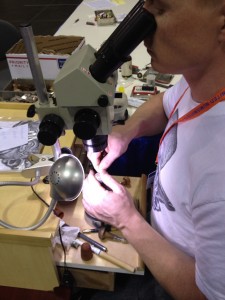
A modern Buffalo Nickel artist carves coins at the FUN Show
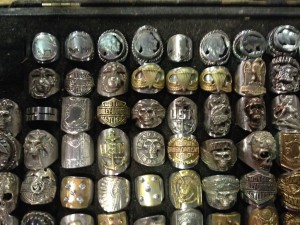
The rings from another artists features designs using coins (see top row)
Another fun area was the panning for gold. On the other side of the hall was a large booth set up with troughs that had mud and tiny gold nuggets. It was fun to walk up and watch the kids swirl the pan and find a tiny gold nugget. I do not know how much gold was in that water, but it was a lot of fun giving it a try. No, I did not find a gold nugget!
Of the large shows I have attended, FUN has had the most diverse attendance. There seemed to be more families, women, and minorities than even at the World’s Fair of Money. Another pleasant surprise was the number of women taking the lead with the young numismatists around the bourse floor and many of those YNs being girls. There were also quite a few Hispanic collectors with their YNs buzzing around the floor. Since I do not speak Spanish I could tell they were enjoying themselves just be observing their body language.
Diversity is good in both the hobby and life. No single group has the answers and attracting people with diverse backgrounds and perspectives is good for everyone. I do not know if the organizers of FUN advertise the show in minority communities or in areas that would attract diverse interests, but they should share what they do with the rest of the numismatic community since it is working.
As for my purchases, I was looking for a few silver bullion coins. Of the ones on my personal want list I was able to pick up the 2013 25th Anniversary Canadian Silver Maple Leaf and the 2014 Chinese Panda. I did not find the 2013 all-silver Britannia and I forgot about the 2013 and 2014 Australian Silver Koala. Since I already own the 2013 American Silver Eagle Proof, I should be almost caught up with my silver collection.
In my attempt to find something that I can say “oh… neat,” I did find three items that category. First, to add to my New York City collection is a Type 2 or “Large Y” subway token without the large “Y” punched. This token would have been used from 1970, when the fare was 30-cents, through 1980 for a 50-cents fare. I have seen many mis-punched tokens, but this is the first I have seen without the “Y.”
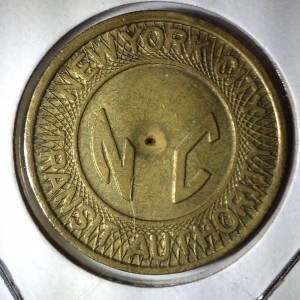
New York City Type 2 Subway Token error. It’s missing the punched out “Y”
My next “oh… neat” item is a Dad’s root beer bottle cap but with a 1953-D Lincoln cent wedged inside the cap. I do not know if this was done by Dad’s or someone else, but the folding of the cap around the coin looks too perfect to have been done manually. Even if it was done by someone as a good luck piece, it was very interesting.
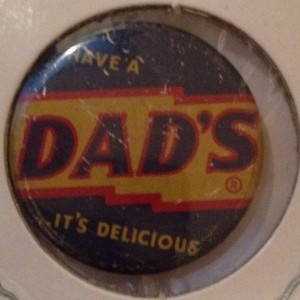
The bottle cap of a Dad’s Root Beer bottle. A 1953-D Lincoln cent is embedded in the reverse!
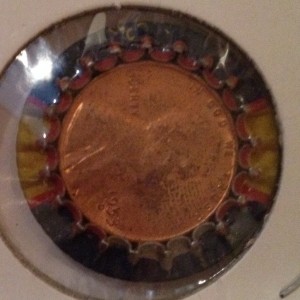
A 1953-D Lincoln Cent is “trapped” inside this Dad’s Root beer bottle cap
Finally, I found a 1940’s era oil rationing coupon book. Obviously issued during the war, the coupon book limited the holder to up to $25 of home heating oil from the Service Oil Company of Hibbing, Minnesota. Hibbing is in what can be described as northeast Minnesota where it is not exactly warm. As I type this, the Weather Channel is reporting that the temperature in Hibbing a 1F! What makes this coupon book unusual is that it is unused with all the coupons attached from frigid norther Minnesota. It has survived over 60 years in nearly pristine condition. Now that is “oh… neat!”
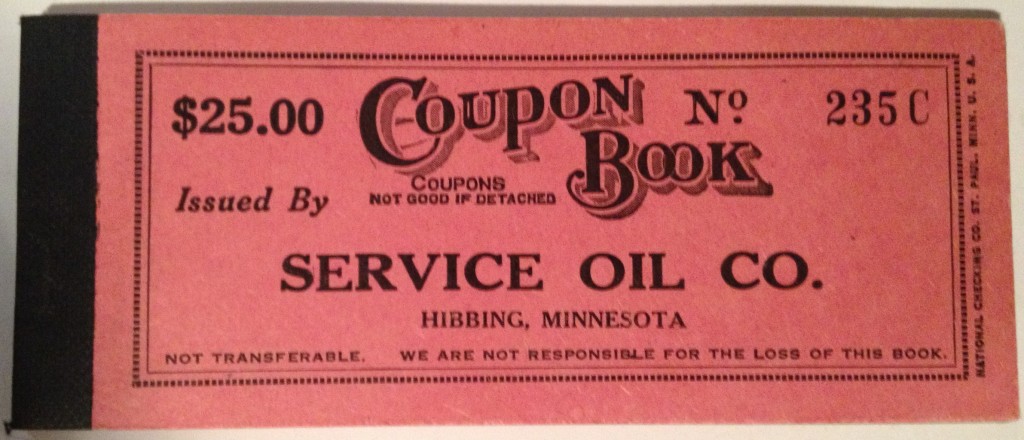
A never used home heating oil rationing coupon book from the World War II era.
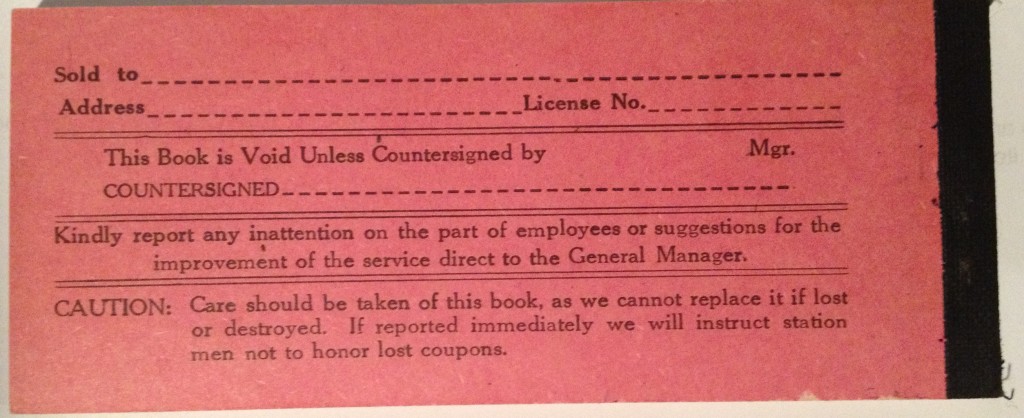
Back cover of an unused home heating oil coupon book. It was printed for but never issued by Service Oil Company of Hibbing, MN
If you have not been to FUN you should try to go. At least take the family. They can go to a theme park while you hit the bourse floor!
Photo Album
Jan 10, 2014 | coins, currency, shows
 There is more than Disney and Universal in Orlando. This week the Florida United Numismatists Is having their annual convention at the Orange County Convention Center. FUN is the first show of the calendar year.
There is more than Disney and Universal in Orlando. This week the Florida United Numismatists Is having their annual convention at the Orange County Convention Center. FUN is the first show of the calendar year.
If FUN sets the tone for the coming year, what I saw today was a sign for a good numismatic year. Even arriving later than expected, the bourse floor was a steady buzz throughout the day. There was a lot of activity at both the high end and low end tables.
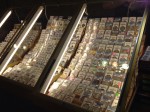
Low Country Coins out of Charleston, SC has a unique way of displaying their coins for sale.
I didn’t buy much today. I spent much of the day schmoozing and looking. Aside from looking at the sale items, I marveled at the items that were not exactly coins. There are quite a few jewelry and other antique items at the show. One thing I noticed was a lot of paper and paper money dealers. While I have seen notaphily and scripophily dealers at other shows, there seems to be quite a few here in Orlando.
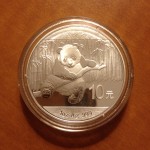
I did buy this 2014 Chinese Silver Panda. I love the Pandas!
In fact, the Heritage Platinum Night Currency auction was held before a full house. While I missed the few colonials I was interested in seeing, I found that the prices realized were well beyond even Heritage’s estimate.
Rather than stand in the back of the room of the currency auction I was not going to bid on, I went to the next room to sit and watch The Adam Mervis Large Cent Collection auction. Aside that I was watching one of the more interesting collection of large cents being broken up, I was enjoying the show being put on by the auctioneers. One of the auctioneers, Bob Merrill, had a great rapport with the audience and really made the auction interesting to watch, even for a non-bidder.
Even though the Heritage auctioneers are good, they seem to miss bids during the furor of the bidding. On more than one occasion with more than one auctioneer, bids were missed that would have significantly jumped the price. Heritage could learn a bit from the classic car and other auctions that are held at large venues and have spotters stand on the floor to help get the attention of the auctioneer. While I have seen this with the big car auctions on television, I have been to estate and bankruptcy auctions in larger places where they use spotters to ensure the bids are noticed.
Dear Heritage: you bring enough people to these auctions, why not add one or two of your people per room to patrol the floor in help the auctioneer. Or why not hire someone to do that at the show. I am sure you can find collectors interested in making a few extra dollars to feed their coin buying habit.
Those following me on Twitter at @coinsblog may have seen many of the pictures I have taken. Eventually, I will post them to Pinterest but I am having connectivity issues. If you want to see the pictures I did take, go to my iCloud Photostream to see all of the pictures, including the ones that did not make it to Twitter. For those who have never experienced an auction, there are two short videos from the large cent auction from where I was sitting.
More FUN tomorrow!
Jan 9, 2014 | coins, shows
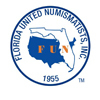 By the time this posts, I will be on an airplane heading to Orlando, Florida for the Florida United Numismatics (F.U.N.) Convention. This will be the first time I am attending this show. Not only am I going for the fun (pun intended), I am also attending representing the Maryland State Numismatic Association as the new president.
By the time this posts, I will be on an airplane heading to Orlando, Florida for the Florida United Numismatics (F.U.N.) Convention. This will be the first time I am attending this show. Not only am I going for the fun (pun intended), I am also attending representing the Maryland State Numismatic Association as the new president.
Of course I will be on Twitter (@coinsblog) sharing my thoughts and some pictures while at the show. Depending on connectivity and health of my device’s batteries, I will also publish pictures on Pinterest on the board “2014 F.U.N. Convention.”
Jan 8, 2014 | coins, commentary, Eagles, news, other
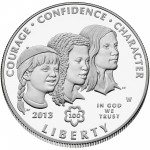
2013 Girl Scouts of the USA Centennial commemorative coin
Following the close of the year, the U.S. Mint told Coin World that the sales of the 2013-W Girl Scouts of the USA Centennial Commemorative coins was so low that it did not cover the costs of the program as required by law. U.S. Mint records show that 86,354 proof and 37,463 uncirculated coins were sold for a total of 123,817 coins. That is a little more than 35-percent of the 350,000 authorized by the law.
Sales of the 2013-W Girl Scouts of the USA Centennial Commemorative coins was to have ended on December 17, 2013 but the U.S. Mint extended the sale through December 31, 2013. By law, a commemorative coin can only be sold in the year it was struck.
The U.S. Mint cannot be faulted for this lack of interest. Information about the coin had been a fixture of the front page of the U.S. Mint’s website. Their information included a video introduction by United States Treasurer Rosie Rios and provided information in its various outreach programs. The U.S. Mint is limited on the type of advertising it is allowed to use.
Usually, the burden of advertising falls to the organization that would most benefit from the sale of the commemorative coin. Since I do not have a connection with Girl Scouts of the USA, I cannot report on their promotional experience.
This news is both sad and troubling. Although there are collectors who will buy the coin to be part of their commemorative collection, the real success or failure of a commemorative coin is based on its subject. For whatever reasons, the Girl Scouts was not a popular subject.
When a commemorative is made for an organization, purchasers want some affinity for the organization. Unless you are a collector, you are not going to buy a coin honoring that organization, especially when the price is over $50 during a recovering economy. I wonder if a clad half-dollar may have been a better idea?
While having a program to honor the centennial of the Girl Scouts of the U.S.A. was a laudable idea, maybe it was not a good one. It was a coin with a limited appeal and those in the target audience did not respond.
It is also troubling that the Girl Scouts were not able to generate more sales on its own. In coming up over 31,000 coins short of being able to receive the payout, it is time to question the diversity of the hobby—again.
Numismatics is dominated by middle-aged to older white males. While there is an outreach to young numismatists, those programs appear to succeed in recruiting mostly white boys and keeping them interested until they become 18 years old.
Consequently, there appears to be no concentration on providing opportunities to young girls and minorities. While the Boy Scouts provide one outlet, local experience shows that those troops are dominated by young white males. Surely there are girls and minorities interested in numismatics. If not, why not?
If anyone missed the point, the executive directors of the American Numismatic Association and Industry Council for Tangible Assets (ICTA) are women. I do not believe either have their jobs because they are women. They are qualified people leading an industry that happens to male dominated.
There has to be a way to appeal to the demographics that are not being represented in the hobby. Aside from women and minorities, the hobby has to figure out how to engage those older than young numismatist (YN) but younger than middle-age. There has to be a way to keep them interested if they started as a YN or grab their interest before middle age. In 2011 I addressed these issues calling potential members the “Lost Demographic.” There have been little changes since.
What will it take to expand the hobby to all sectors of society? Please feel free to let me know in the comments section below. We can all work together for the betterment of the hobby!
Jan 3, 2014 | coin design, coins, commemorative, commentary, COTY
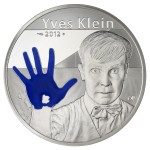
Monnaie de Paris 2012 Yves Klein commemorative was named 2014 Coin of the Year

2011 Commemorative celebrating the 100th anniversary of the Royal Dutch Mint’s facilities with QR code on reverse
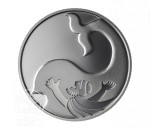
2010 Jonah In The Whale 2-New Sheqalim coin from Israel

2009 White Rhinoceros 100 Rand gold coin from South Africa
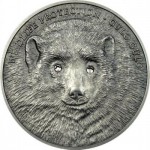
2008 Mongolia Wolverine with diamonds for eyes
Three of the last five COTY winners had design elements that were not based on the sculpture of the coin but on a design gimmick. Were these the best designs or did the gimmick influence the voting?
I have asked before whether it is wrong to include other design elements on a coin, especially non-circulating legal tender (NCLT) coins. When I ask these questions, I bring out the picture of my Somalia motorcycle or muscle car coins. I also like the Canadian 2006 Breast Cancer silver commemorative coin and the special 25-cent circulating coin the Royal Canadian Mint produced. These were not overt uses of color but almost an enhancement to emphasize the pink ribbons on the coins.
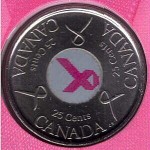
2006 Breast Cancer Quarter was Canada’s first colored circulating coin
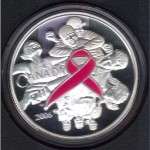
2006 Breast Cancer Silver Coin with colored pink ribbon.
But is it too much of a gimmick? After the RCM produced those coins it seems that they dove in face first into producing colored coins. It also seems that the rest of the world also has been spending its time printing coins and not minting them (see the New Zealand Mint). Although I am guilty of buying into this type of design concept, there comes a time when the concept has gone too far. In television the concept is called “Jumping the Shark.”
While others are printing coins, the Royal Mint is coming up with designs that are interesting sculptures. In fact, if you go to their website and look at their offerings you will find that the Royal Mint has nice designs, interesting packaging, but no color. Although their artists take advantage of the design elements using bi-metallic coins, they are sculptured arts and not printed designs.
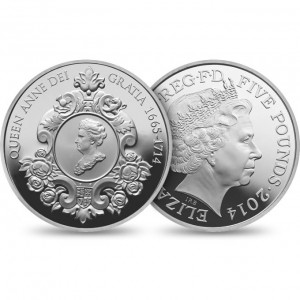
2014 £5 crown commemorating the 300th anniversary of the death of Queen Anne
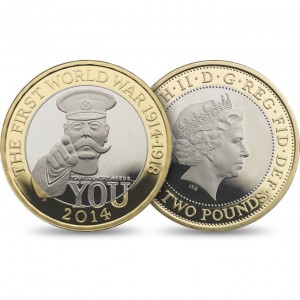
2014 £2 coin commemorating the 100 year anniversary of the start of World War I
U.S. coin designs have had the best designs over the last few years. However, the introduction of the “enhanced uncirculated” coins with the selective frosting has opened up new ways of enhancing sculpture elements on coins. It would be interesting to see what the U.S. Mint artists can do if given the free hand to design coins and using the laser to enhance the design.
Given the recent history of the COTY competition, the 2014 National Baseball Hall of Fame commemorative coin is almost a shoo-in for 2016 COTY honors. While the elements will be sculpted rather than printed and the curved planchet will be interesting, it is probably enough of a gimmick to sway the World Coin News confab when it meets to discuss the 2014 coin in December 2015.
As an aside, why do we have to wait a year for the COTY competition? With technology what it is today, why does it take a year to do the COTY competition? If the award is given in February, then why select the COTY in December or January? Does it really make sense for the 2014 COTY to be coins date 2012? Why not call it the 2012 COTY since the coins are dated 2012 and award them at the beginning of 2013—or in this case, the 2013 COTY being awarded in 2014?
The one year delay might have made sense when mail delivery was less reliable and information was delayed by the speed of the teletype and the printing press. In the information age where 2012 is not only yesterday’s news it is ancient history, it is time for Krause Publications and World Coin News to modernize their process and come up with something a little quicker than a one year delay.
Image Credits
- 2012 Yves Klein commemorative courtesy of the Monnaie de Paris.
- 2011 Royal Dutch Mint commemorative with QR code courtesy of the Royal Dutch Mint.
- 2010 Jonah in the Whale commemorative courtesy of the Israel Coins & Medals Corp.
- 2009 White Rhinoceros 100 Rand gold coin courtesy of Krause Publications.
- 2008 Mongolia Wolverine coin courtesy of the Wolverine Foundation.
- 2014 British coin images courtesy of the Royal Mint.



 It is not a demographic issue as it is a commitment to the hobby’s future. I am sure the people at
It is not a demographic issue as it is a commitment to the hobby’s future. I am sure the people at 



 If you have not read “
If you have not read “

 According to a
According to a 






















